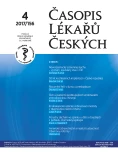30 years of the cochlear implantations in the Czech Republic
Authors:
Jan Bouček 1; Jan Kluh 1; Zdeněk Čada 1; Jan Vokřál 2; Libor Černý 2; Tomáš Tichý 3; Jiří Skřivan 4; Jan Betka 1; Jan Plzák 1
Authors‘ workplace:
Klinika otorinolaryngologie a chirurgie hlavy a krku 1. LF UK a FN Motol, Praha
1; Foniatrická klinika 1. LF UK a VFN v Praze
2; Cochlear Czech Republic, Praha
3; Klinika ušní, nosní a krční 2. LF UK a FN Motol, Praha
4
Published in:
Čas. Lék. čes. 2017; 156: 178-182
Category:
Review Articles
Overview
Cochlear implant is the unique sensory neuroprosthesis and still the only one used in clinical praxis. The function of the inner ear is replaced with direct electrical stimulation of the cochlear nerve. It is 30 years since the first cochlear implantation has been performed with the Czech single-channel cochlear neuroprosthesis. There are more than one thousand users of cochlear implants in the Czech Republic nowadays. Cochlear implants have become a standard of care of patients with severe hearing loss. It allows user inclusion to the society with only a minimum of obstacles.
Key words:
cochlear implant, history, neuroprosthesis, severe hearing loss
Sources
1. Dai C, Lehar M, Sun DQ et al. Rhesus cochlear and vestibular functions are preserved after inner ear injection of saline volume sufficient for gene therapy delivery. J Assoc Res Otolaryngol 2017; 18(4): 601–617.
2. Staecker H. Inner ear gene therapy. IFOS 2017.
3. Staecker H, Schlecker C, Kraft S et al. Optimizing Atoh1-induced vestibular hair cell regeneration. Laryngoscope 2014; 124(Suppl. 5): S1–S12.
4. Mudry A, Mills M. The early history of the cochlear implant: a retrospective. JAMA Otolaryngol Head Neck Surg 2013; 139(5): 446–453.
5. Djourno A, Eyries C, Vallancien B. [Electric excitation of the cochlear nerve in man by induction at a distance with the aid of micro-coil included in the fixture.] C R Seances Soc Biol Fil 1957; 151(3): 423–425.
6. Djourno A, Eyries C. [Auditory prosthesis by means of a distant electrical stimulation of the sensory nerve with the use of an indwelt coiling.] Presse Med 1957; 65(63): 1417.
7. House WF. Cochlear implants. Ann Otol Rhinol Laryngol 1976; 85 suppl. 27(3 Pt. 2): 1–93.
8. House LR. Cochlear implant: the beginning. Laryngoscope 1987; 97(8 Pt. 1): 996–997.
9. Simmons FB. Electrical stimulation of the auditory nerve in man. Arch Otolaryngol 1966; 84(1): 2–54.
10. Simmons FB, Epley JM, Lummis RC et al. Auditory nerve: electrical stimulation in man. Science 1965; 148(3666): 104–106.
11. Clark GM. Responses of cells in the superior olivary complex of the cat to electrical stimulation of the auditory nerve. Exp Neurol 1969; 24(1): 124–136.
12. Clark GM. Hearing due to electrical stimulation of the auditory system. Med J Aust 1969; 1(26): 1346–1348.
13. Clark GM, Pyman BC, Bailey QR. The surgery for multiple-electrode cochlear implantations. J Laryngol Otol 1979; 93(3): 215–223.
14. Pourová R, Janoušek P, Jurovčík M et al. Spectrum and frequency of SLC26A4 mutations among Czech patients with early hearing loss with and without enlarged vestibular aqueduct (EVA). Ann Hum Genet 2010; 74(4): 299–307.
15. Holden LK, Finley CC, Firszt JB et al. Factors affecting open-set word recognition in adults with cochlear implants. Ear Hear 2013; 34(3): 342–360.
16. Holden LK, Firszt JB, Reeder RM et al. Factors affecting outcomes in cochlear implant recipients implanted with a perimodiolar electrode array located in scala tympani. Otol Neurotol 2016; 37(10): 1662–1668.
17. Scherf FW, van Deun L, van Wieringen A et al. Functional outcome of sequential bilateral cochlear implantation in young children: 36 months postoperative results. Int J Pediatr Otorhinolaryngol 2009; 73(5): 723–730.
18. Wu CC, Lin YH, Liu TC et al. Identifying children with poor cochlear implantation outcomes using massively parallel sequencing. Medicine (Baltimore) 2015; 94(27): e1073.
19. Delmaghani S, Defourny J, Aghaie A et al. Hypervulnerability to sound exposure through impaired adaptive proliferation of peroxisomes. Cell 2015; 163(4): 894–906.
20. Delmaghani S, del Castillo FJ, Michel V et al. Mutations in the gene encoding pejvakin, a newly identified protein of the afferent auditory pathway, cause DFNB59 auditory neuropathy. Nat Genet 2006; 38(7): 770–778.
21. Bouček J, Vokřál J, Černý L et al. Baha implant as a hearing solution for single-sided deafness after retrosigmoid approach for the vestibular schwannoma: surgical results. Eur Arch Otorhinolaryngol 2017; 274(6): 2429–2436.
22. Bouček J, Vokřál J, Černý L et al. Baha implant as a hearing solution for single-sided deafness after retrosigmoid approach for the vestibular schwannoma: audiological results. Eur Arch Otorhinolaryngol 2017; 274(1): 133–141.
23. Mertens G, De Bodt M, Van de Heyning P. Cochlear implantation as a long-term treatment for ipsilateral incapacitating tinnitus in subjects with unilateral hearing loss up to 10 years. Hear Res 2016; 331 : 1–6.
Labels
Addictology Allergology and clinical immunology Angiology Audiology Clinical biochemistry Dermatology & STDs Paediatric gastroenterology Paediatric surgery Paediatric cardiology Paediatric neurology Paediatric ENT Paediatric psychiatry Paediatric rheumatology Diabetology Pharmacy Vascular surgery Pain management Dental HygienistArticle was published in
Journal of Czech Physicians

Most read in this issue
- Newborn hearing screening – importance, current state in the Czech Republic
- Sore throat treatment
- Sleep-related breathing disorders in children and adults from the aspect of the otorhinolaryngology
- 30 years of the cochlear implantations in the Czech Republic
